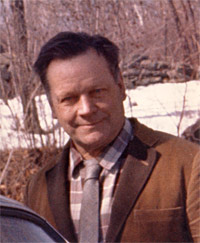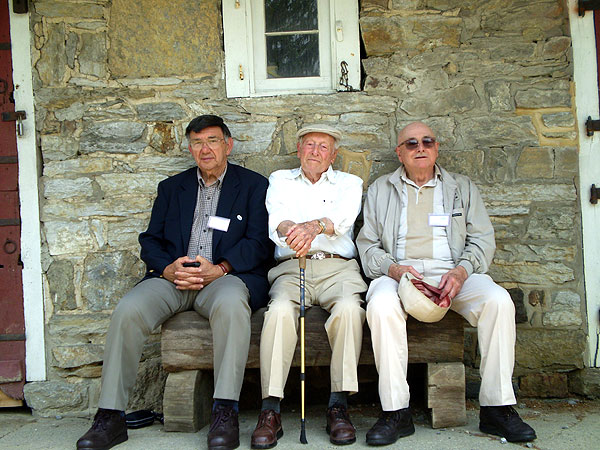We owe much of our knowledge of North American barn
architecture to several fine authors. However, the
great and varied topic of North American barns actually
had a poor press until the mid 1950’s. It
was in 1954 that the famed painter of early Americana
Eric Sloane wrote the first book
on barns that ever appeared on the continent —
American Barns and Covered Bridges. Later
in 1966 his classic book was published – An
Age of Barns where he discussed a wide diversity
of barn types. It could be said that Sloane was
the first to put barns on the proverbial map. To
him we owe a great debt of gratitude to both his
pioneering spirit and enthusiasm. He among the other
authors listed here is considered thee pioneer barn
author. Greg Huber met Eric Sloane perhaps a dozen
times. |
|
 Eric Sloane
Eric Sloane |
Pennsylvania itself produced four barn historians and
they are found in the names of – Alfred Shoemaker,
John Heyl, Joseph Glass and Robert Ensminger —
all native Pennsylvanians. Each man has made a significant
contribution to the knowledge of barns of Pennsylvania
and each man’s work is distinguished from the
other.

 |
| Barn authors
(from L to R) Joseph Glass, John Heyl, and Robert
Ensminger |
Alfred Shoemaker was the editor of the first
book exclusively devoted to barns in Pennsylvania. Among
four other authors, Shoemaker himself contributed twelve
articles to this initial effort that appeared in 1955.
John Heyl was born in April 1906 just
eight days after the earthquake that shook San Francisco.
He is in excellent health. John along with architect
Charles Dornbusch in 1958 wrote the book Pennsylvania
German Barns. This book was the first attempt at
the delineation of barn types by construction means.
Greg Huber first met John Heyl in October of 1992.
Joseph Glass from Millersville in Lancaster
County wrote his PHD dissertation in 1969 called “The
Pennsylvania Culture Region – A Geographic Interpretation
of Barns and Farmhouses.” Later in 1986 the
basic material was transformed into a book called The
PA Culture Region – A View from the Barn.
After Heyl and Dornbusch’s book it was the first
true scholarly attempt in book length form. Greg Huber
first met Joseph Glass in July 1992. Joseph was born
in 1930.
Robert Ensminger wrote his classic
book in 1992 — The Pennsylvania Barn –
Its Origin, Evolution and Distribution in North America.
The greatest contribution in this book consists of three
things. First — tracing the European connection
or origin to eastern Switzerland – principally
in Pratigau. Second — a classification of the
Pennsylvania barn was created. Three classes of barns
were recognized along with almost two dozen types. Third
— the distribution of the barn type which extended
far beyond the boundaries of Pennsylvania. His work
has had the greatest influence in affecting EBC’s
work on the barns of Pennsylvania. Greg Huber first
met Robert Ensminger in July 1976. They have maintained
a close personal friendship in the past twenty years.
Bob was born in 1927.
Henry Glassie, the great folklore scholar
researched and wrote treatises on barns in the early
to mid 1960’s and he contributed a solid base
of knowledge of American barns especially those originating
from Pennsylvania. Other work he did was published in
a long article often considered a classic — Barn
Building in Otsego County, New York that included
a windshield survey of nearly 2,200 barns. Greg Huber
first met Henry Glassie in January 1978. In February
2002 he conducted a three hour personal interview of
Henry at State College, PA. Henry was born in 1941.
John Fitchen was another early contributor
to the awareness of barns and his classic work –
The New World Dutch Barn appeared in 1968. This was
the first genuine attempt by a trained architect to
delineate the major structural characteristics of a
major North American barn type that was erected in eastern
New York and the northern half of New Jersey. With the
examination of more than 600 barns Greg Huber later
expanded upon his work in the 1975 to 2005 time frame.
In 2001 he did an in-depth expansion and editing of
the second edition of his book. Greg met John Fitchen
the first and only time in September 1978 at his home
in Hamilton, New York. He spoke to John a few times
on the phone. John died in 1990.
Eric Arthur and Dudley Witney, two
Canadian based authors in 1972 produced their classic
half scholarly-half coffee table book The Barn —
A Vanishing Landmark in North America. It is replete
with illustrations of early and later built barns throughout
much of the continent. This book may well have been
an important stimulus for a number of books that came
out after about 1975. Most of them are not scholarly
treatises. Greg Huber first met Dudley Witney in May
2001. Dudley was born in May 1926
The 1975 to 2009 era has seen literally dozens of books
appear before the consuming public. Almost all of the
authors of the books have not been trained – albeit
by means of their own disciplined studies or lack there-of
– the fine constructions points of the barns they
present in their books.
|
|